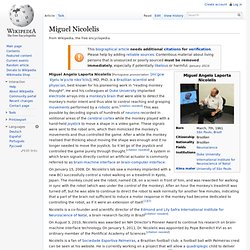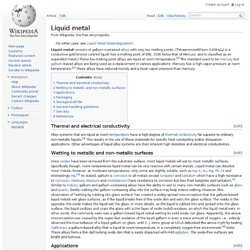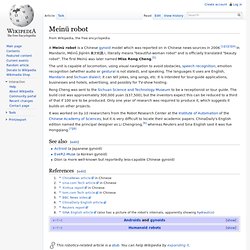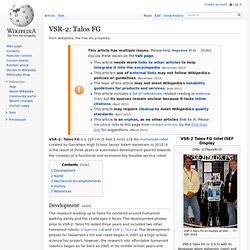

Miguel Nicolelis. Miguel Angelo Laporta Nicolelis (Portuguese pronunciation: [miˈɡɛw ˈɐ̃ʒelu lɐˈpɔɾtɐ nikoˈlɛlis]), MD, PhD, is a Brazilian scientist and physician, best known for his pioneering work in "reading monkey thought".

He and his colleagues at Duke University implanted electrode arrays into a monkey's brain that were able to detect the monkey's motor intent and thus able to control reaching and grasping movements performed by a robotic arm. [citation needed] This was possible by decoding signals of hundreds of neurons recorded in volitional areas of the cerebral cortex while the monkey played with a hand-held joystick to move a shape in a video game. These signals were sent to the robot arm, which then mimicked the monkey's movements and thus controlled the game. After a while the monkey realised that thinking about moving the shape was enough and it no longer needed to move the joystick. So it let go of the joystick and controlled the game purely through thought.
On January 15, 2008, Dr. Liquid metal. Consists of gallium-contained alloys with very low melting points.

(Tetraamminelithium (Li(NH 3 ) 4 ) is a conductive gold bronze colored liquid, has a melting point of 89K, 150K below that of Mercury, and is classified as an expanded metal.) These low melting point alloys are liquid at room temperature. [ 1 ] The standard used to be mercury but gallium -based alloys are being used as a replacement in various applications. Mercury has a high vapor pressure at room temperature. [ 2 ] These alloys have reduced toxicity and a lower vapor pressure than mercury. Alloy systems that are liquid at room temperature have a high degree of thermal conductivity far superior to ordinary non-metallic liquids. [ 3 ] This results in the use of these materials for specific heat conducting and/or dissipation applications. Other advantages of liquid alloy systems are their inherent high densities and electrical conductivities.
Liquid metal is usually packaged in polyethylene bottles. Cosmobot. CosmoBot History[edit] The concept of CosmoBot was created by Dr.

Corinna Lathan, who cofounded AnthroTronix, Inc. with Jack Vice in 1999. The entire CosmoBot system is manufactured and marketed by AT KidSystems, Inc[2]. Development of CosmoBot was sponsored by the National Institutes of Health and the National Science Foundation. Theory[edit] Why was it designed? CosmoBot was designed as an assistive tool for therapists and educators working with developmentally and learning disabled children, including those with autism and cerebral palsy. Design goals[edit] The most important goal of CosmoBot is to provide long-term motivation for children to actively participate in therapy and to help children achieve goals set by therapists and educators. Target Audience[edit] CosmoBot is intended for use by developmentally disabled children ages 5-12 under the guidance of a therapist or educator.
Meinü robot. A Meinü robot is a Chinese gynoid model which was reported on in Chinese news sources in 2006.[1][2][3][4] In Mandarin, Měinǚ Jīqìrén 美女机器人 literally means "beautiful-woman robot" and is officially translated "beauty robot".

The first Meinü was later named Miss Rong Cheng.[5] The unit is capable of locomotion, using visual navigation to avoid obstacles, speech recognition, emotion recognition (whether audio or gestural is not stated), and speaking. The languages it uses are English, Mandarin and Sichuan dialect. It can tell jokes, sing songs, etc. It is intended for tour-guide applications, businesses and hotels, advertising, and possibly for TV-show hosting. Rong Cheng was sent to the Sichuan Science and Technology Museum to be a receptionist or tour guide. It was worked on by 10 researchers from the Robot Research Center at the Institute of Automation of the Chinese Academy of Sciences, but it is very difficult to locate their academic papers. RoboSapien. RoboSapien is a toy-like biomorphic robot designed by Mark Tilden and produced by WowWee toys.

The RoboSapien is preprogrammed with moves, and also can be controlled by an infrared remote control included with the toy, or by either a personal computer equipped with an infrared transmitter or an infrared transmitter-equipped PDA. The toy's remote control unit has a total of 21 different buttons. With the help of two shift buttons, a total of 67 different robot-executable commands are accessible. Overview[edit] The toy is capable of a walking motion without recourse to wheels within its feet.
Released in 2004, the product was very successful over the Christmas season, with over 1.5 million units sold between April and December 2004.[1] VSR-2: Talos FG. VSR-2: Talos FG is a 155 cm (5 foot 1 inch) 118 lbs. humanoid robot created by Garretson High School Senior Adam Halverson in 2010.

It is the result of three years of automaton development geared towards the creation of a functional and economically feasible service robot. Development[edit] The research leading up to Talos FG centered around humanoid walking ability and the challenges it faces. The development phases prior to VSR-2: Talos FG lasted three years and included two other humanoid robots: X-Species 2 and VSR-1: Talos. The development phases for Halverson's full size robot began in 2007 as a high school science fair project, however, the research into affordable humanoid robotics began as far back as 2005 in his middle school years and included his former partner, Anthony Winterton.
Kobian.